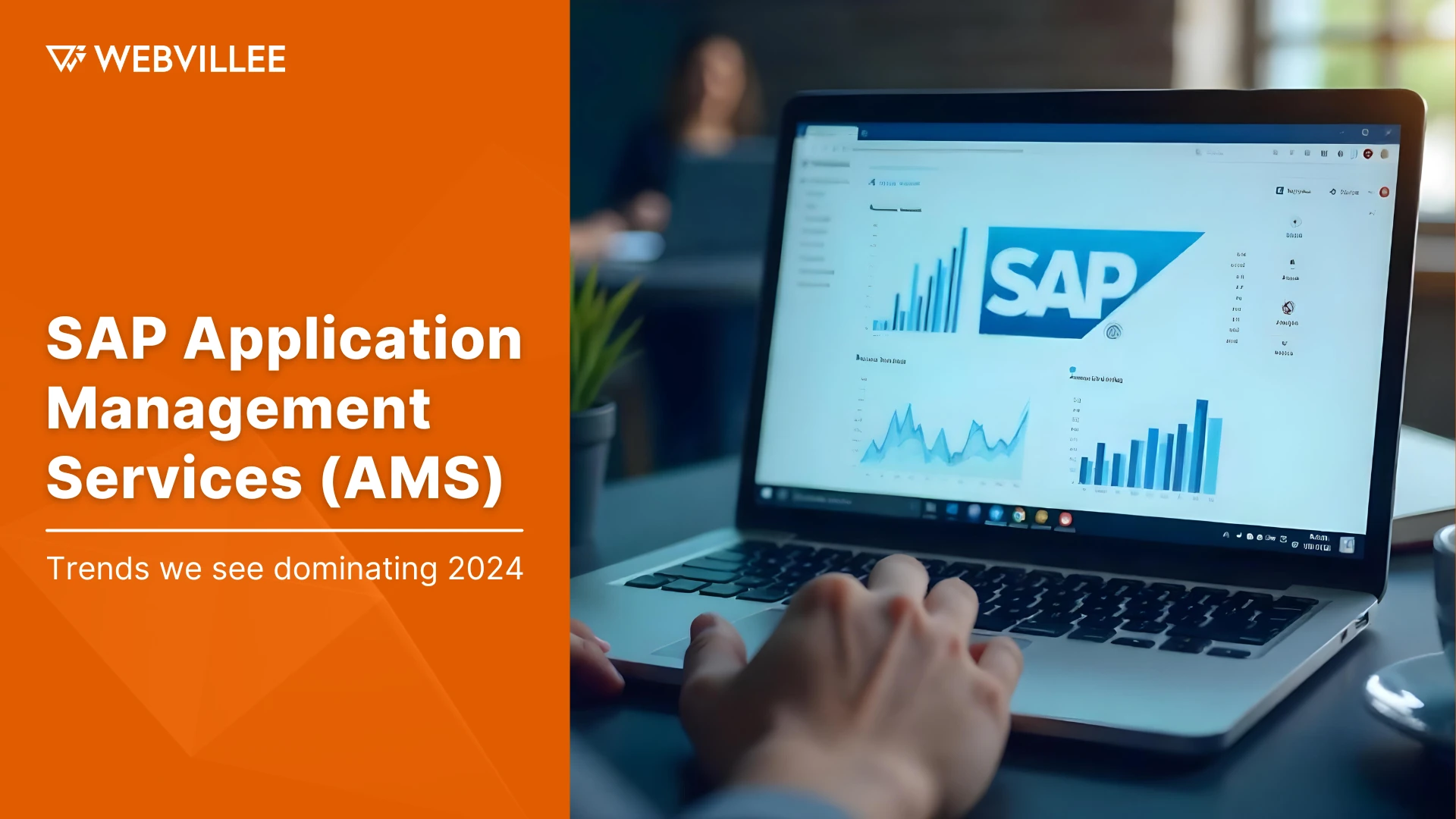The rapid evolution of technology continues to shape how businesses operate, and digitalization is at the forefront of this transformation. As organizations strive to keep up with industry demands and remain competitive, SAP Application Management Services (SAP AMS) play a pivotal role in ensuring their SAP systems remain optimized and fully integrated.
As we enter 2024, several emerging trends are set to dominate the SAP AMS landscape, enabling businesses to unlock new efficiencies, enhance system performance, and drive growth.
This blog will explore these trends and highlight why SAP AMS remains a crucial component of any modern digital transformation journey.
The Rise of Cloud-First Solutions
The shift to the cloud has been one of the most significant technological developments in recent years, and it continues to gain momentum. SAP has been at the forefront of this change, with solutions like RISE with SAP enabling businesses to migrate to the cloud seamlessly.
In 2024, cloud adoption will dominate as organizations embrace flexible, scalable, and cost-efficient models for managing their SAP solutions. The adoption of cloud-native platforms such as SAP S/4HANA has made cloud migration a necessity for businesses aiming to maintain competitive advantage.
Cloud computing offers several key benefits, including reduced Total Cost of Ownership (TCO), faster innovation cycles, and increased agility. As companies deploy SAP on the cloud, it becomes easier to implement new updates, functionalities, and enhancements, ensuring they stay ahead of the curve.
However, while cloud-first solutions offer significant advantages, they also bring challenges. For many businesses, especially in sectors like defense, public sector, or healthcare, concerns about data privacy and security remain prominent.
These industries may continue to prefer on-premise or hybrid solutions, where full control over sensitive data is maintained.
The Role of AI and Automation in AMS
As digital transformation accelerates, organizations increasingly turn to artificial intelligence (AI) and automation to optimize operations and improve system performance. AI is revolutionizing the way SAP AMS is delivered by enabling predictive analytics, automated testing, and robotic process automation (RPA).
In 2024, predictive analytics will play a major role in preventing issues before they occur. By leveraging AI, businesses can identify potential system failures and resolve them proactively, ensuring smoother operations and reducing downtime. Automation, on the other hand, helps streamline routine tasks, reduce manual errors, and free up valuable resources for strategic activities. By automating workflows and processes, organizations can improve productivity and reduce operational costs.
AI-driven tools, such as machine learning models, will further enhance the accuracy and efficiency of decision-making processes within AMS. This will empower businesses to identify patterns in data and optimize their SAP systems in real-time, ensuring optimal performance and reliability. Ultimately, AI and automation will become indispensable in the SAP AMS ecosystem, driving efficiency and ensuring businesses can meet the evolving demands of the market.
Cloud-Native Application Lifecycle Management (ALM)
With the increasing complexity of hybrid IT environments, organizations need a unified solution for managing the entire lifecycle of their SAP applications. Cloud-native Application Lifecycle Management (ALM) solutions are emerging as a key trend, providing businesses with the tools to monitor, optimize, and troubleshoot their SAP systems more effectively.
SAP Cloud ALM is gaining traction as the go-to solution for managing SAP applications in the cloud. This platform enables real-time monitoring, diagnostics, and seamless scalability, which are essential for managing applications in a multi-cloud or hybrid environment. By adopting cloud-native ALM solutions, businesses can streamline their SAP application management, reduce complexity, and ensure continuous innovation.
In 2024, we can expect the adoption of cloud-native ALM to expand, as companies look for more efficient ways to manage SAP applications and integrate them with non-SAP applications. As businesses rely on diverse technology stacks, including solutions from Microsoft, Salesforce, and Adobe, achieving seamless integration and interoperability across platforms will be vital for success. Cloud-native ALM will become a cornerstone for businesses seeking to manage their SAP ecosystem effectively and deliver continuous value.
Integration with DevOps and Agile Practices
The integration of DevOps and agile methodologies with SAP AMS will continue to shape the way businesses approach application development, deployment, and maintenance.
DevOps practices, such as Continuous Integration (CI) and Continuous Delivery (CD), allow businesses to release software updates faster and more reliably, ensuring that their SAP applications can adapt quickly to changing business needs.
By adopting agile and DevOps practices within their AMS framework, organizations can foster a culture of continuous improvement. This will enable faster turnaround times for software releases, better collaboration between IT teams, and more frequent updates to SAP systems. As a result, businesses can enhance their ability to respond to market demands, innovate rapidly, and deliver higher-quality solutions.
In 2024, integrating DevOps with AMS will be crucial for businesses aiming to achieve greater operational efficiency and improve the overall quality of their SAP applications. This approach will also contribute to a more flexible and responsive IT environment, which is necessary for adapting to the ever-evolving business landscape.
User-centric design and Enhanced UX
As businesses continue to digitize their operations, **user experience (UX)** becomes an increasingly important consideration in AMS solutions. In 2024, SAP AMS solutions will emphasize creating intuitive, user-friendly interfaces that make it easier for IT teams to manage and optimize SAP applications.
Modern SAP AMS solutions will focus on simplifying the management of complex systems through customizable dashboards, advanced analytics, and deeper insights into system health. A user-centric approach to AMS ensures that businesses can quickly identify and resolve issues, optimize system performance, and make data-driven decisions with ease.
The emphasis on UX will empower IT teams to manage their SAP applications more effectively, while also enabling better collaboration and communication between business and IT departments. This shift will make SAP AMS more accessible and efficient, helping businesses get the most value from their SAP investments.
Sustainability and Green IT
In line with broader industry trends, sustainability is becoming an increasingly important consideration for businesses in 2024. Green IT and sustainability practices are gaining prominence in the context of SAP AMS, with companies seeking ways to reduce their environmental impact and promote eco-friendly practices in their technology operations.
Key areas of focus for businesses adopting sustainable AMS practices include energy-efficient data centers, optimized resource usage, and the reduction of carbon footprints. In 2024, businesses will look to SAP AMS to help them achieve sustainability goals by adopting energy-efficient solutions, minimizing waste, and embracing eco-friendly software development and deployment practices.
As environmental concerns grow, integrating sustainability into SAP AMS will not only benefit the planet but also improve a company’s reputation and appeal to environmentally-conscious consumers. Businesses that prioritize sustainability in their AMS solutions will be well-positioned to meet the evolving expectations of customers, regulators, and stakeholders.
Data-Driven Decision-Making
Data-driven decision-making continues to be a cornerstone of business success in the digital era. In 2024, advanced analytics will play a crucial role in driving continuous improvement within SAP AMS. By leveraging predictive maintenance, performance monitoring, and usage analytics, organizations can gain actionable insights that help optimize their SAP applications.
With real-time data and analytics, businesses can monitor system performance, identify potential issues, and implement improvements that drive long-term success. In this data-driven landscape, organizations can make informed decisions to improve operational efficiency, reduce costs, and enhance system reliability.
Conclusion
As SAP Application Management Services evolve in 2024, businesses must adapt to the latest trends and technologies to stay ahead of the competition. The convergence of cloud adoption, AI and automation, integration with DevOps, user-centric design, and sustainability will play a significant role in shaping the future of AMS. By embracing these trends, businesses can unlock new efficiencies, drive innovation, and ensure their SAP applications remain optimized for success.
In this rapidly changing digital landscape, SAP AMS is no longer just a service—it’s a strategic enabler that empowers businesses to streamline operations, reduce costs, and stay ahead of emerging trends. As companies navigate the complexities of digital transformation, SAP AMS will remain an essential tool for achieving operational excellence, fostering growth, and driving innovation.
Ready to enhance your business processes with Webvillee? Our expert services ensure that your systems work together flawlessly, streamlining operations and boosting productivity. Contact us today to discover how we can provide digital transformation to fit your unique needs and drive your business forward. Don’t miss out on the opportunity to optimize your integration and achieve seamless business success!

